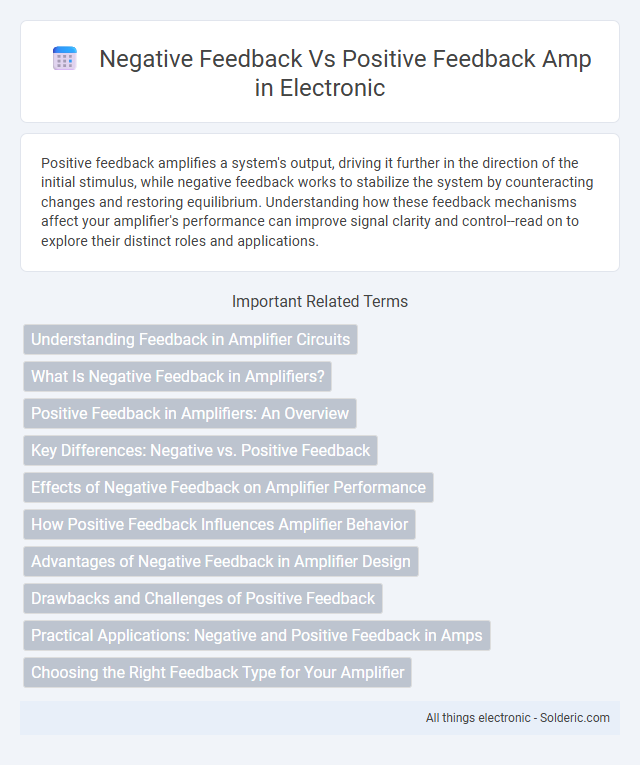Positive feedback amplifies a system's output, driving it further in the direction of the initial stimulus, while negative feedback works to stabilize the system by counteracting changes and restoring equilibrium. Understanding how these feedback mechanisms affect your amplifier's performance can improve signal clarity and control--read on to explore their distinct roles and applications.
Comparison Table
| Feature | Negative Feedback Amplifier | Positive Feedback Amplifier |
|---|---|---|
| Feedback Type | Signal fed back is out of phase (180deg) | Signal fed back is in phase (0deg) |
| Effect on Gain | Decreases gain, improves stability | Increases gain, can cause instability |
| Stability | Enhances amplifier stability | May lead to oscillations or instability |
| Common Applications | Audio amplifiers, operational amplifiers for linear operation | Oscillators, Schmitt triggers, regenerative receivers |
| Output Behavior | Reduces distortion, bandwidth increase | May cause output saturation or oscillations |
| Phase Shift | 180deg phase shift in feedback | 0deg phase shift in feedback |
| Loop Gain | Loop gain < 1 for stability | Loop gain >= 1 may lead to oscillation |
Understanding Feedback in Amplifier Circuits
Feedback in amplifier circuits plays a crucial role in determining the performance and stability of the system. Negative feedback reduces distortion, lowers gain, and increases bandwidth by feeding a portion of the output signal back to the input in opposite phase, improving accuracy and linearity. Positive feedback, on the other hand, reinforces the input signal, which can lead to oscillations and is commonly used in oscillator circuits rather than amplification stability.
What Is Negative Feedback in Amplifiers?
Negative feedback in amplifiers refers to the process where a portion of the output signal is inverted and fed back to the input, reducing the overall gain but enhancing stability, bandwidth, and linearity. This technique minimizes distortion and noise, ensuring higher fidelity in your audio or signal processing applications. Compared to positive feedback, negative feedback prevents oscillations and improves the amplifier's performance by keeping the output under tighter control.
Positive Feedback in Amplifiers: An Overview
Positive feedback in amplifiers occurs when a portion of the output signal is fed back to the input in phase, enhancing the input signal and increasing gain. This feedback mechanism can lead to higher amplification, improved sensitivity, and potential oscillation if the gain exceeds unity. Properly controlled positive feedback is crucial in applications such as oscillators and regenerative receivers, where it sustains signal generation.
Key Differences: Negative vs. Positive Feedback
Negative feedback in amplifiers stabilizes the gain by feeding a portion of the output signal back to the input out of phase, reducing distortion and improving linearity. Positive feedback, in contrast, reinforces the input signal by feeding it back in phase, which can increase gain but often leads to instability or oscillations. Understanding these key differences helps you design amplifier circuits with desired performance characteristics and stability.
Effects of Negative Feedback on Amplifier Performance
Negative feedback in amplifiers significantly improves stability, reduces distortion, and enhances bandwidth by feeding a portion of the output signal back to the input in opposition to the incoming signal. This process lowers gain but increases linearity and decreases sensitivity to component variations, noise, and temperature changes, optimizing your amplifier's overall performance. Negative feedback also minimizes harmonic distortion and increases input and output impedance, ensuring more precise signal amplification.
How Positive Feedback Influences Amplifier Behavior
Positive feedback in amplifiers increases gain and can lead to instability or oscillation by reinforcing the output signal into the input. This feedback reduces input impedance and can cause distortion as the amplifier departs from linear operation. By contrast, negative feedback stabilizes gain, improves bandwidth, and reduces distortion, making positive feedback critical in oscillator circuits rather than typical amplification stages.
Advantages of Negative Feedback in Amplifier Design
Negative feedback in amplifier design enhances stability by reducing gain variations caused by component tolerances and temperature changes. It improves linearity and reduces distortion, leading to higher fidelity in audio and signal processing applications. Your amplifier benefits from a wider bandwidth and lower noise levels, making negative feedback a crucial technique for precise and reliable performance.
Drawbacks and Challenges of Positive Feedback
Positive feedback amplifiers can cause instability and oscillations in circuits due to their tendency to reinforce deviations, making system control more challenging. They often lead to distortion and saturation, which degrade signal fidelity and limit linear operation. Managing these drawbacks requires careful design and compensation techniques to maintain reliable and predictable performance.
Practical Applications: Negative and Positive Feedback in Amps
Negative feedback in amps enhances stability, reduces distortion, and improves bandwidth, making it ideal for high-fidelity audio systems and precision instrumentation. Positive feedback increases gain and can drive oscillation, which is useful for oscillator circuits and audio signal generators. Your choice between negative and positive feedback depends on whether you prioritize signal accuracy or amplification power in practical applications.
Choosing the Right Feedback Type for Your Amplifier
Choosing the right feedback type for your amplifier depends on desired sound characteristics and stability requirements. Negative feedback reduces distortion and improves bandwidth by feeding a portion of the output signal back to the input in opposite phase, enhancing linearity and minimizing noise. Positive feedback increases gain and can produce oscillations, making it useful for specific applications like oscillators but generally unsuitable for high-fidelity audio amplification due to potential instability.
negative feedback vs positive feedback amp Infographic

 solderic.com
solderic.com